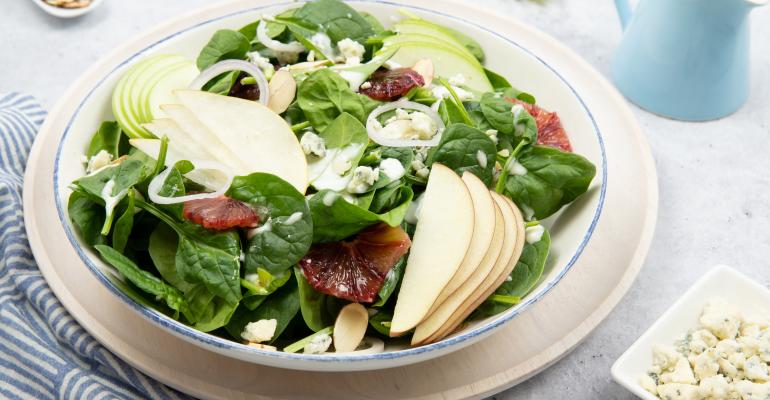Sponsored by Litehouse
The entrée salad—which first gained main menu prominence alongside the rise of California cuisine in the 1980s—is the lunch item of choice for today’s young consumers.
Proof of its prowess can be found by visiting any one of the growing number of salad-centric concepts at lunchtime to witness long lines of the under-25 set waiting to get their greens. Additionally, the latest research from Datassential reports that entrée salads are now the No. 1 item on lunch menus, out-ranking even the ever-popular sandwich.
But despite the growing popularity of entrée salads, operators still must consider a targeted approach to marketing and selling these items.
Generation salad
While salads have broad appeal to many different consumers, they are nearly the perfect food for Generation Z, those aged 18 to 24. Here are just a few reasons why restaurants selling entrée salads should be targeting the youngest generation:
- Big and getting bigger. Gen Z is now the largest generation in the United states, having surpassed millennials by nearly 4 million last year. And they are growing fast. The latest United Nation’s World Population data reports Gen Z currently numbers 86 million, and is expected to grow to 88 million over the next 20 years. That’s potentially a lot of salad orders.
- Food quality comes first. When it comes to what they eat, most Gen Z individuals were raised to value the quality of food as well as its flavor and function. They are a generation known to prefer fresh and wholesome foods, more organic and natural foods, and food without additives.
- Many are vegetarians. Gen Zers are more likely than other generations to be vegetarians, according to a new report from Packaged Facts. Some 65% of Gen Z say they want a more “plant-forward” diet, while 79% would eat meatless meals once or twice a week, according to a recent study conducted by Aramark.
Marketing tips for selling salads
Growing up with a focus on the flavor and function of food rather than brand will make Gen Zs more challenging for restaurant marketers to reach—but certainly not impossible. Below are some recommendations for positioning entrée salads to this young cohort.
Get personal
Nine out of 10 consumers say the idea of a personalized diet is a long-term trend, not a passing fad, according to Datassential’s The New Healthy Keynote Report. The wild success of the many restaurant concepts that are dedicated to build-your-own salads—from Chopt to Saladworks to Sweetgreen—make it clear that consumers want to create entrée salads to their unique specifications and health preferences. Generation Z is especially looking for personalization, according to The NPD Group.
Dress for success
Dressing is the most important component in an entrée salad—second only to lettuce and fresh veggies—for Gen Z consumers in the West Region.
For restaurants, especially full-service concepts and those with broader menus that don’t have room to store an endless number of ingredients, one easy way to add options is with dressings. But for a generation that considers food an expression of who they are, that dressing had better be special.
Partnering with a foodservice supplier or manufacturer can help operators develop chef-driven dressings that are flavorful, on-trend and differentiate the brand. Serving singular sauce options can also give Gen Z customers the control they crave, and the ability to be bold or basic depending on the day. Among the salad dressings this age group says they haven’t tried but are somewhat or very interested in experiencing are Lemon Vinaigrette, Goddess, Jalapeño Ranch and Hatch Chile.
Change it up
Menu fatigue is the enemy of salad success, especially with Zers. To keep things fresh, many operators market entrée salads by offering a regular rotation of specials.
Chef innovations, together with the introduction of novel ingredients and fresh flavor combinations, are a way to both capture consumers’ ever-changing tastes and keep them coming back again and again. Try adding one of the age-group's top salad ingredients, such as bean sprouts, corn or jalapeño peppers, or showcasing less-familiar seasonal ingredients, such as fiddlehead ferns or ramps.
Get online
This is the generation that grew up with technology, the Internet and social media, so if you want to market to its members your brand must be active online, especially on social media.
Gen Zers always have their phones and they wield them to preview restaurant menus on Facebook, take food photos, split the check and post instant reviews. Perhaps most important, Upserve reports that many Gen Zs decide where to dine based on a restaurant’s social media accounts.
In the end, to attract Gen Z to your restaurant, keep the entrée salad menu fresh, flexible and innovative. And, of course, be sure to take to social media to tweet, ‘gram or post about your latest entrée salads.




